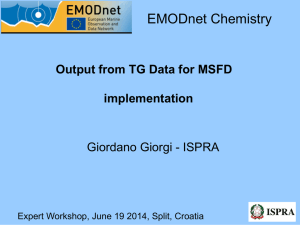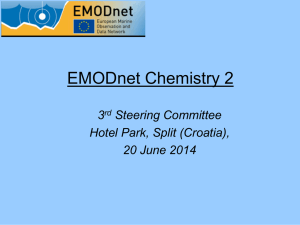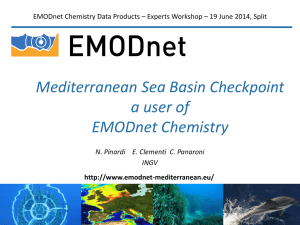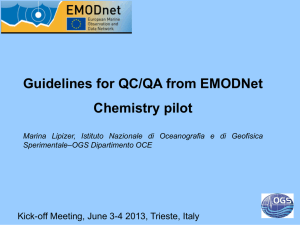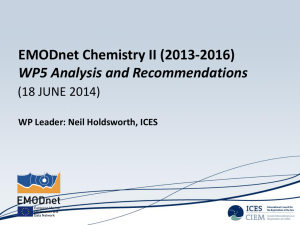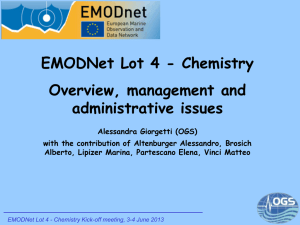DIKE_10-2014-08 (MSFD
advertisement
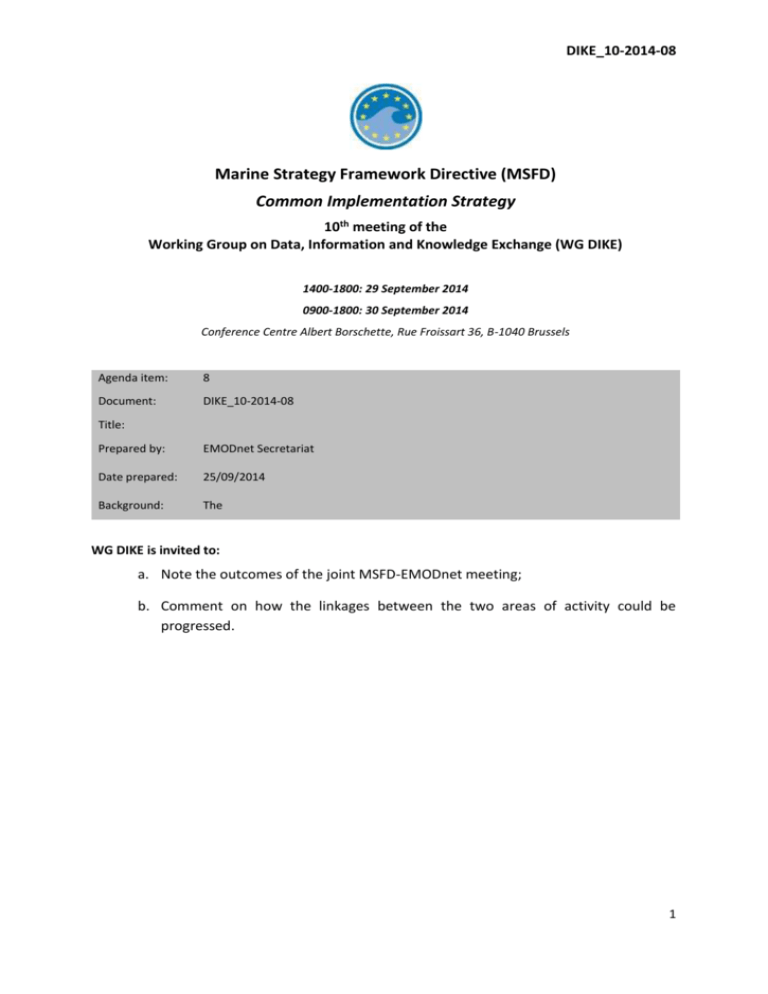
DIKE_10-2014-08 Marine Strategy Framework Directive (MSFD) Common Implementation Strategy 10th meeting of the Working Group on Data, Information and Knowledge Exchange (WG DIKE) 1400-1800: 29 September 2014 0900-1800: 30 September 2014 Conference Centre Albert Borschette, Rue Froissart 36, B-1040 Brussels Agenda item: 8 Document: DIKE_10-2014-08 Title: Prepared by: EMODnet Secretariat Date prepared: 25/09/2014 Background: The WG DIKE is invited to: a. Note the outcomes of the joint MSFD-EMODnet meeting; b. Comment on how the linkages between the two areas of activity could be progressed. 1 DIKE_10-2014-08 EMODnet-MSFD coordination meeting (Brussels) 9th September 2014 When: 9 September 2014 from 9:00 to 17:30 Where: Brussels, DG MARE, Rue Joseph II 79/99 - MARE ROOM J99 05/86 DIR GEN MEETING ROOM Participants: Iain Shepherd (DG MARE), Trine Christiansen (EEA), David Connor (DG ENV), Giordano Giordi (ISPRA, Italy) and Niels Kinneging (RWS, Netherlands) as Member State MSFD representatives, Vivi Fleming-Lehtinen (HELCOM) and Emily Corcoran (OSPAR) as Regional Sea Convention representatives, Jan-Bart Calewaert, Phil Weaver and Liesbeth Renders (EMODnet Secretariat), Simon Claus (EMODnet Biology), Alessandra Giorgetti, Matteo Vinci and Dick Schaap (EMODnet Chemistry), Neil Holdsworth (ICES). Meeting Chair: David Connor On 9 September 2014, European Marine Observation and Data Network (EMODnet) Secretariat brought together MSFD (Marine Strategy Framework Directive) and EMODnet actors to consider how EMODnet could contribute to - and benefit from - the MSFD process. For example, EMODnet could not only make available data and products in a way useful for MSFD indicator development/assessment, but it could also provide methods and technology to Member States for decentralised reporting. Other way around, data used in MSFD reporting could be made more available through EMODnet (if not already the case). A clear win-win situation. Background EMODnet is a long term marine data initiative developed through a stepwise approach aiming to ensure that European marine data will become more easily accessible, interoperable and free of restrictions on use. EMODnet started in 2009 and now brings together more than 110 organisations working together to assemble marine datasets with the specific target of developing a multiresolution map of the entire seabed and overlying water column of European waters by 2020. One of the core concepts behind EMODnet is to collect European marine data once and then make them available for multiple use(rs). A core group of envisaged users of the EMODnet service are the Member States, Regional Seas Conventions and European bodies which require marine data and products in the framework of environmental monitoring, assessment and reporting, in particular in relation to the MSFD. Member States are responsible for the monitoring, assessment and reporting under the legal obligations by MSFD. MSFD stimulates the involvement of Regional Sea Conventions as they have long standing experience and established relationships with Member States on marine environmental assessment and monitoring. Over the past years several interactions have already taken place between members of the EMODnet and MSFD communities at various levels and occasions to consider how EMODnet could be more useful for MSFD reporting. However this has never been done in a targeted, coordinated way but rather based on ad hoc interactions, pre-existing personal and institutional links between people and organisations involved in both processes. With the start of EMODnet phase II it is now very timely to pick up the pace in a coordinated process to identify how EMODnet can best contribute in practical terms to the MSFD and what concrete actions are required to make this happen. Main objectives - Informing all actors about the current status of both initiatives; Agree on a coordinated interaction process to consolidate collaboration and pave the way for efficient interactions in the future; 2 DIKE_10-2014-08 - Outline potential contributions and consider concrete steps to ensure EMODnet can be of more use to MSFD in the future. Consider steps to ensure that all data collected in the framework of MSFD is made available through EMODnet channels. Approach The meeting focussed on chemistry and biodiversity themes with four selected MSFD indicators as these together cover many scenarios for indicator use across the descriptors: - Biodiversity (1): Mobile species and water column habitats - Biodiversity (2): Seabed habitats/seafloor integrity (D1/D6) - Chemistry (1): Nutrients/chlorophyll/oxygen (D5) - Chemistry (2) Contaminants (D8/9) For each of these, participants discussed current practices by Member States and Regional Conventions to calculate descriptors now, what EMODnet could provide today and in the future in terms of data, tools and products as well as what would be needed to make EMODnet more suitable for use. Presentations Meeting participants provided following main presentations: - - Jan-Bart Calewaert briefly presented EMODnet framework, current status and future perspectives. Simon Claus elaborated how EMODnet Biology could contribute, in particular zooming in on efforts to date to identify species that will comprise indicators or components of indicators for the MSFD. Alessandra Giorgetti presented an overview of some areas where EMODnet Chemistry would be able to contribute. Giordano Giorgi presented his perspectives as a representative from a Southern European Member State. Niels Kinneging provided a presentation with his views on options for collaboration between EMODnet and MSFD. Vivi Fleming-Lehtinen presented the HELCOM Eutrophication Assessment Tool (HEAT). Conclusions - - - Participants agreed the meeting was very informative and timely. All acknowledged the need to continue the dialogue in a structured process and agreed to assist by o acting as interlocutors between the different organizations and experts involved; o fostering interactions between MSFD and EMODnet at the right levels (e.g. by identifying the right technical experts or opportunities to collaborate); o acting as a soundboard to provide feedback on strategic matters where appropriate and relevant. The EMODnet Secretariat agreed to initially facilitate the informal ‘MSFD-EMODnet’ coordination group represented by the meeting attendants and consider ways to develop a dedicated ‘EMODnet-MSFD’ user/task group. OSPAR and HELCOM representatives congratulated EMODnet Biology and Chemistry for the wide range of activities and products already available and other ones under development, most of which were unknown to them. However, the activities and products presented at the meeting are not reflected on the thematic portals themselves. This could be improved by 3 DIKE_10-2014-08 - - clearly communicating ongoing developments and listing the data/products which are expected to be released in the (near) future. EMODnet Seabed habitats and EMODnet Human activities were identified as thematic lots which merit more attention as some of their outputs may also be very relevant for MSFD actors. EMODnet Human activities is a new project in this phase and could be useful for assessing several MSFD pressures and as such would benefit from more intensive follow up at this initial stage of development. ICES plays a critical role with involvement in data management aspects of both EEA, HELCOM, OSPAR, EMODnet Biology and EMODnet Chemistry. During the assessment and testing of the EMODnet portals, MSFD actors identified a number of specific shortcomings and areas for improvement of the EMODnet Biology and Chemistry portals. These will be included in the Secretariat user-evaluation reports (one for each portal) for follow up by thematic coordinators. Actions / next steps 1. EMODnet Biology to engage directly with OSPAR and HELCOM experts at upcoming COBAM meeting in October and report back to the Secretariat. 2. EMODnet thematic lots to indicate on their portal/webpages the status of the work in progress by adding an overview of data/products/tools which will be released in the future. 3. EMODnet Secretariat and thematic lots to consider adding a standard ‘disclaimer’ on the EMODnet central and thematic pages to indicate that ‘EMODnet is work in progress / under development’ and that user-feedback and involvement to help guide the work is highly appreciated. 4. MSFD actors to provide all comments, observations and recommendations on specific portal aspects to the EMODnet Secretariat for follow up. 5. EMODnet Secretariat to integrate specific comments and recommendations from MSFD actors in the Secretariat User-Evaluation Report, follow up with thematic portals and report back on the implementation. 6. EEA to ensure that the concerns and needs of Member States from all regional sea-basins are taken into consideration. Giordano Giordi and EEA to report back to the Barcelona Convention and Black Sea Commission (BSC). 7. Member States representatives to present at various fora (e.g. WG DIKE, TG DATA, at national level, …) with assistance from EEA on opportunities offered by EMODnet and current EMODnet-MSFD interactions. In first instance, Niels Kinneging and Trine Christiansen (EEA) will present the outcomes of this meeting to the upcoming WG DIKE meeting (29-30 September 2014). 8. EMODnet Secretariat to inform EMODnet Seabed habitats about the findings of this meeting and recommendations from ISPRA. If necessary a separate meeting with EMODnet Seabed habitats and Biology may be considered. 9. EMODnet Secretariat to organise a meeting with EMODnet Human activities coordinator and interested stakeholders to guide further development of the Human activities portal. 10. EMODnet Secretariat to report to the EMODnet Steering Committee (Brussels, December 2014) on the interactions and consider a list of priorities of implementation by the thematic portals. 4
